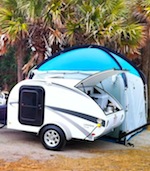bobditch wrote:You have a nice setup.
THANKS!
bobditch wrote:I'm curious about the volt meter and reverse lights you added.. Can you sent me some pics and install info...
I tend to get long winded, so please bear with me:
Because of our work schedules, we usually head-out on camping trips Thursday late afternoon. Often enough, this makes it dark by the time we get to the campsite. As much as I love my wife, she doesn't understand backing a trailer, therefore is terrible help trying to back into a slot in the dark. So I added back-up lights to the trailer.
I got a $20 set of fog/driving lights from Walmart, and mounted them inside the ends of the tongue tubes (the ends are open just underneath the side doors). They fit just perfect inside the tube and they angle just perfect to shine on the tires and out to the sides and behind the trailer.
The alternator on my car is just powerful enough to keep the car going, so I didn't want to stress it more with charging the trailer battery. So, I replaced the 7-pin connector on the trailer with a flat 5-pin connector. 5-pin is becoming the new standard for boats, as it has all the normal 4-pin functions, plus a reverse pin to lock-out surge brakes for reversing (and back-up lights). I re-wired my car from flat 4-pin to flat 5-pin (tapping the reverse lights) - which will still plug into a flat 4-pin connector like on my 4x8 utility trailer.
My car has a finicky electrical system anyways, so I didn't want to over-power the cars reverse light circuit... So, I got a waterproof project box, and a relay from Fry's. I mounted the project box onto the battery box and ran all the wires through a grommeted hole between the two. The cars reverse lights close a relay in the project box, to turn on the trailer reverse lights which are powered by the trailer battery. Sounds complicated, but it's really simple - and keeps the cars electrical system isolated from the trailers.
I figured while I was at it (and at Fry's) I got a waterproof volt meter, and a waterproof momentary button switch - I drilled a large hole (actually used the 3-axis at work to do it) in the cover of the project box to mount the volt gauge and a smaller hole for the button. I just tapped into the power leads for the relay, and now anytime I want to check the battery voltage, I just push the button ant the meter shows the voltage. It's debate-able how useful the meter is, but it was easy, fun, and just may keep me from killing the battery sometime.
I'll snap a couple pics of the lights and meter/project box and post them...

